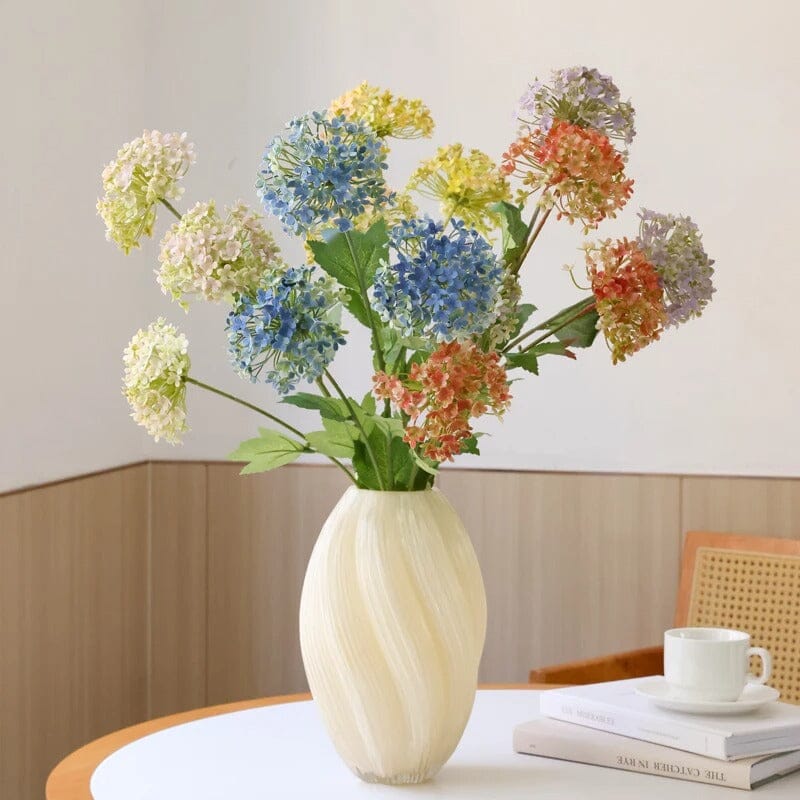The hydrangea, with its large inflorescences and varied colors, is a flower that embodies beauty and emotion. Discover its fascinating history and its rich symbolism in the language of flowers.

🌸 1. Origin and History of Hydrangea
Native to Asia and America, the hydrangea has a long history that goes back millions of years. The first fossil traces of this plant date back about 40 to 50 million years, found in North America. Over time, this majestic flower has crossed continents and eras to become a universal symbol of beauty and gratitude.
🌍 Fun Fact: Did you know that Japan was the first country to cultivate hydrangeas for ornamental purposes? During the Edo period (1603-1868), hydrangeas were prized for beautifying imperial gardens and temples.
The name "hydrangea" was given by the botanist Philibert Commerson in the 18th century, during his expedition around the world with Bougainville. Some say that this name was inspired by a woman of the French court, Hortense of Nassau, while others claim that Commerson wanted to honor his companion, Jeanne Baret, who traveled disguised as a man to circumvent the restrictions of the time.
🌿 Interesting fact: In Japanese, hydrangea is called "Ajisai" and symbolizes gratitude for changing love, due to the ability of some varieties to change color depending on the pH of the soil.
When it arrived in Europe in the 18th century, the hydrangea was grown primarily in greenhouses for its ornamental qualities. In France, it has become a garden staple thanks to its vibrant colors and long flowering period, which extends from late spring to fall. Today, it is one of the most popular plants in the world, both outdoors and indoors.
🌟 A universal symbol: Hydrangea is often used at weddings and important ceremonies. In Korea, it is associated with prosperity and hope, while in Europe, it represents elegance and abundance.
🌸 2. Meaning of Hydrangea

The hydrangea is a flower rich in symbolism, reflecting a great diversity of emotions and meanings depending on cultures and eras. Its large inflorescences, often composed of dozens of small flowers, make it a symbol of gratitude, understanding, and abundance. The complexity of its meaning also lies in the variety of its colors, each of which brings a different nuance to its message.
🌟 Fun fact: In Japan, hydrangea is often associated with gratitude and apology. It is said that an emperor offered these flowers to be forgiven by his beloved after a misunderstanding.
🌈 The Meaning of Colors
Each color of hydrangea carries a particular meaning:
- Blue: Symbol of forgiveness and understanding, it often expresses deep and sincere emotions.
- Pink: Associated with love, femininity and tenderness, it is ideal for expressing sweet and romantic feelings.
- White: Synonymous with purity and grace, it is often used during solemn or spiritual ceremonies.
- Violet: It embodies royalty and mystery, perfect for conveying subtle and intriguing messages.
🖤 Also discover: The Meaning of the Black Rose
Delve into the mystery and captivating symbolism of this unique flower.
🌿 Fun fact: The color of a hydrangea can change depending on the pH of the soil. Acidic soils produce blue flowers, while alkaline soils produce pink flowers.
💫 Gratitude and Recognition
Hydrangea is often given as a gift to express deep gratitude and appreciation. Its lush, abundant flowers symbolize sincere recognition and a generous message of "thank you." This meaning is particularly prevalent in Asian countries, where it is frequently used to honor loved ones and celebrate moments of sharing.
🌸 A universal symbol: In France, the hydrangea is often associated with the celebration of family ties, while in China, it symbolizes unity and harmony.
🌿 Also discover: Clematis and its Timeless Elegance
Explore the refined beauty and powerful symbolism of this unique climbing plant.
💖 Love and Emotion
With its delicate hues, the hydrangea is also a symbol of love and sincere emotions. It can convey feelings ranging from sweet affection to deeper passion, depending on its color and arrangement. It is an ideal flower for special occasions like weddings, where it symbolizes the timeless beauty of union and promises.
🌟 Bottom line: Hydrangea is a multifaceted flower, capable of expressing gratitude, love, and even mystery, depending on the message you want to convey.
🌹 Also discover: The Meaning of the Orange Rose
Discover how this flower symbolizes passion and creative energy.
🌸 Artificial Hydrangea: Long-Lasting Beauty and Timeless Elegance
Artificial hydrangea is an ideal solution for those who wish to integrate the captivating beauty of this flower into their interior, without the constraints of maintaining natural flowers. Made with high-quality materials, it accurately reproduces the velvety texture of the petals and the richness of the colors characteristic of the natural hydrangea. Whether to enhance a living space, enrich a floral arrangement, or decorate an event, the artificial hydrangea brings a touch of elegance and timeless refinement.
One of the main advantages of artificial hydrangeas is their longevity. Unlike their natural counterparts, they do not fade and remain vibrant throughout the year. They are a practical and economical option for those who like to surround their homes with flowers, but want to avoid the expense and time of maintaining live plants. Easy to clean and available in a wide range of sizes and colors, artificial hydrangeas fit perfectly into any style of decoration, from classic to modern.
🌸 Also discover: The Meaning of the Cherry Blossom
Explore the deep symbolism and spirituality attached to this iconic flower.
🌸 Conclusion
Hydrangea is a fascinating flower that combines beauty, complexity, and emotion. Whether it is to express your gratitude, celebrate a sincere love, or simply beautify a space, hydrangea is a flower that never fails to impress.













Leave a comment